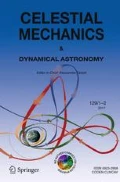Abstract
We obtain an approximate solution \(\tilde{E}=\tilde{E}(e,M)\) of Kepler’s equation \(E-e\sin (E)=M\) for any \(e\in [0,1)\) and \(M\in [0,\pi ]\). Our solution is guaranteed, via Smale’s \(\alpha \)-theory, to converge to the actual solution \(E\) through Newton’s method at quadratic speed, i.e. the \(n\)-th iteration produces a value \(E_n\) such that \(|E_n-E|\le (\frac{1}{2})^{2^n-1}|\tilde{E}-E|\). The formula provided for \(\tilde{E}\) is a piecewise rational function with conditions defined by polynomial inequalities, except for a small region near \(e=1\) and \(M=0\), where a single cubic root is used. We also show that the root operation is unavoidable, by proving that no approximate solution can be computed in the entire region \([0,1)\times [0,\pi ]\) if only rational functions are allowed in each branch.






Similar content being viewed by others
References
Battin, R.H.: An Introduction to the Mathematics and Methods of Astrodynamics. American Institute of Aeronautics and Astronautics, New York (1987)
Calvo, M., Elipe, A., Montijano, J.I., Rández, L.: Optimal starters for solving the elliptic Kepler’s equation. Celest. Mech. Dyn. Astron. 115, 143–160 (2013)
Colwell, P.: Solving Kepler’s Equation Over Three Centuries. Willmann-Bell, Richmond, VA (1993)
Danby, J.M.A.: The solution of Kepler’s equation III. Celest. Mech. 40, 303–312 (1987)
Danby, J.M.A., Burkardt, T.M.: The solution of Kepler’s equation I. Celest. Mech. 31, 95–107 (1983)
Markley, F.L.: Kepler equation solver. Celest. Mech. Dyn. Astron. 63, 101–111 (1995)
Mikkola, S.: A cubic approximation for Kepler’s equation. Celest. Mech. 40, 329–334 (1987)
Mortari, D., Clochiatti, A.: Solving Kepler’s equation using Bézier curves. Celest. Mech. Dyn. Astron. 99, 45–57 (2007)
Mortari, D., Elipe, A.: Solving Kepler’s equations using implicit functions. Celest. Mech. Dyn. Astron. 118, 1–11 (2014)
Ng, E.W.: A general algorithm for the solution of Kepler’s equation for elliptic orbits. Celest. Mech. 10, 243–249 (1979)
Nijenhuis, A.: Solving Kepler’s equation with high efficiency and accuracy. Celest. Mech. Dyn. Astron. 51, 319–330 (1991)
Odell, A.W., Gooding, R.H.: Procedures for solving Kepler’s equation. Celest. Mech. 38, 307–334 (1986)
Palacios, M.: Kepler equation and accelerated Newton method. J. Comput. App. Math. 138, 335–346 (2002)
Smale, S.: Newton’s method estimates from data at one point. In Ewing, R., Gross, K., Martin, C. (eds.) The Merging of Disciplines: New Directions in Pure, Applied, and Computational Mathematics. Springer, New York (1986)
Taff, L.G., Brennan, T.A.: On solving Kepler’s equation. Celest. Mech. Dyn. Astron. 46, 163–176 (1989)
Wang, X., Han, D.: On dominating sequence method in the point estimate and Smale’s theorem. Sci. China Ser. A 33(2), 135–144 (1990)
Acknowledgments
The authors would like to thank Prof. Antonio Elipe for his valuable help. Second author is partially supported by the MINECO grant MTM2011-22621 and the FQM-327 group (Junta de Andalucía, Spain). Third author is partially supported by the MINECO grant MTM2010-21740-C02-02. Both are also partially supported by the Grupo consolidado E15 “Geometría” (Gobierno de Aragón, Spain) and the “Centro Universitario de la Defensa de Zaragoza” grant ID2013-15.
Author information
Authors and Affiliations
Corresponding author
Rights and permissions
About this article
Cite this article
Avendano, M., Martín-Molina, V. & Ortigas-Galindo, J. Solving Kepler’s equation via Smale’s \(\alpha \)-theory. Celest Mech Dyn Astr 119, 27–44 (2014). https://doi.org/10.1007/s10569-014-9545-8
Received:
Revised:
Accepted:
Published:
Issue Date:
DOI: https://doi.org/10.1007/s10569-014-9545-8


